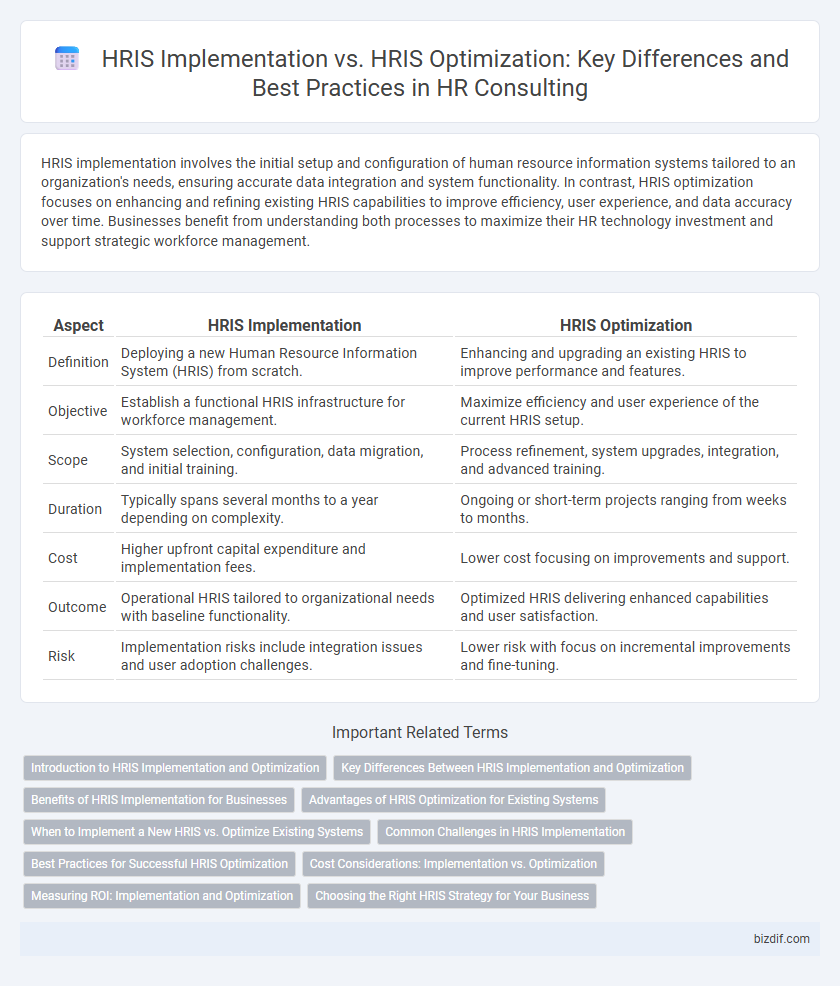HRIS implementation involves the initial setup and configuration of human resource information systems tailored to an organization's needs, ensuring accurate data integration and system functionality. In contrast, HRIS optimization focuses on enhancing and refining existing HRIS capabilities to improve efficiency, user experience, and data accuracy over time. Businesses benefit from understanding both processes to maximize their HR technology investment and support strategic workforce management.
Table of Comparison
| Aspect | HRIS Implementation | HRIS Optimization |
|---|---|---|
| Definition | Deploying a new Human Resource Information System (HRIS) from scratch. | Enhancing and upgrading an existing HRIS to improve performance and features. |
| Objective | Establish a functional HRIS infrastructure for workforce management. | Maximize efficiency and user experience of the current HRIS setup. |
| Scope | System selection, configuration, data migration, and initial training. | Process refinement, system upgrades, integration, and advanced training. |
| Duration | Typically spans several months to a year depending on complexity. | Ongoing or short-term projects ranging from weeks to months. |
| Cost | Higher upfront capital expenditure and implementation fees. | Lower cost focusing on improvements and support. |
| Outcome | Operational HRIS tailored to organizational needs with baseline functionality. | Optimized HRIS delivering enhanced capabilities and user satisfaction. |
| Risk | Implementation risks include integration issues and user adoption challenges. | Lower risk with focus on incremental improvements and fine-tuning. |
Introduction to HRIS Implementation and Optimization
HRIS implementation involves the deployment of a Human Resource Information System from the ground up, encompassing system selection, configuration, data migration, and initial training to ensure seamless integration with business processes. HRIS optimization focuses on enhancing and refining existing HRIS platforms through process improvements, system upgrades, and analytics to maximize operational efficiency and user adoption. Both approaches require strategic alignment with organizational goals and continuous evaluation to drive workforce productivity and data-driven decision-making.
Key Differences Between HRIS Implementation and Optimization
HRIS implementation involves the initial setup and configuration of the Human Resource Information System to align with organizational needs, including data migration, system customization, and employee training. In contrast, HRIS optimization focuses on enhancing existing HRIS performance through process refinement, integration with other business systems, and maximizing user adoption for improved efficiency. Key differences include that implementation is a foundational phase establishing the system, while optimization is a continuous improvement process aimed at leveraging full system capabilities and ensuring long-term HR operational excellence.
Benefits of HRIS Implementation for Businesses
HRIS implementation streamlines workforce management by integrating payroll, attendance, and performance tracking into a centralized system, enhancing data accuracy and reducing administrative costs. This automation boosts employee productivity and supports strategic decision-making through real-time analytics. Improved compliance with labor laws and enhanced data security further protect businesses from regulatory risks and potential breaches.
Advantages of HRIS Optimization for Existing Systems
HRIS optimization enhances existing systems by improving data accuracy, streamlining workflows, and increasing user adoption without the need for costly, time-consuming full implementations. It leverages current infrastructure to deliver faster ROI and supports continuous improvement through real-time analytics and automated processes. Organizations benefit from reduced disruption, customized enhancements, and scalable solutions that adapt to evolving HR needs.
When to Implement a New HRIS vs. Optimize Existing Systems
Implement a new HRIS when existing systems are outdated, lack scalability, or fail to support evolving business processes and compliance requirements. Optimize existing HRIS when the platform remains functional but requires enhancements for improved user experience, integration, or data accuracy. Strategic assessment of current system capabilities versus organizational growth ensures cost-effective HR technology investments and maximizes operational efficiency.
Common Challenges in HRIS Implementation
Common challenges in HRIS implementation include data migration errors, user resistance to change, and inadequate system integration with existing processes. Insufficient training and unclear project scope often lead to delays and increased costs, impacting overall HR efficiency. Proper planning and stakeholder engagement are critical to overcoming these obstacles and ensuring successful HRIS deployment.
Best Practices for Successful HRIS Optimization
Successful HRIS optimization requires continuous data accuracy audits, user training programs, and integration of real-time analytics to enhance decision-making processes. Prioritizing stakeholder feedback and aligning HRIS functionalities with evolving business goals ensures improved employee experience and operational efficiency. Employing agile methodologies and regular system performance assessments drives adaptive improvements and maximizes ROI from existing HRIS investments.
Cost Considerations: Implementation vs. Optimization
HRIS implementation involves significant upfront costs such as software licensing, system customization, data migration, and employee training, often requiring a substantial initial investment. In contrast, HRIS optimization focuses on refining existing systems, leading to lower ongoing expenses by improving efficiency, reducing manual processes, and maximizing current technology use. Companies must assess budget constraints and long-term ROI to determine whether a comprehensive implementation or targeted optimization best aligns with their financial strategy.
Measuring ROI: Implementation and Optimization
Measuring ROI in HRIS implementation involves evaluating the initial costs of software acquisition, integration, and employee training against projected improvements in HR efficiency and data accuracy. In contrast, HRIS optimization focuses on maximizing the return from an existing system by enhancing user adoption, streamlining workflows, and leveraging advanced analytics to drive strategic decision-making. Both approaches require tracking key performance indicators such as time savings, cost reductions, and employee engagement improvements to quantify financial and operational benefits.
Choosing the Right HRIS Strategy for Your Business
Choosing the right HRIS strategy involves assessing whether your business requires HRIS implementation or HRIS optimization. HRIS implementation focuses on deploying a new system tailored to your organization's needs, enhancing data management, payroll processing, and employee self-service capabilities. HRIS optimization refines existing systems to improve efficiency, reduce errors, and enhance user experience by integrating advanced analytics and automation features, ensuring your HR technology aligns with evolving business goals.
HRIS Implementation vs HRIS Optimization Infographic

 bizdif.com
bizdif.com